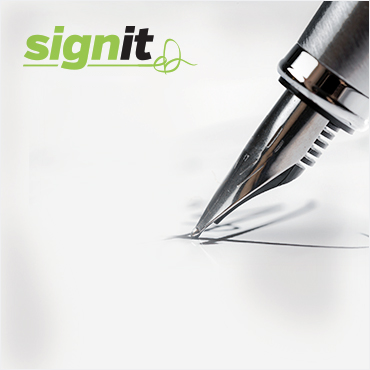Sign up and enjoy the benefits of digital signatures
Key Differences Between Electronic and Digital Signatures
And why we believe the digital approach is the better option

For quite a few years, we've been using electronic and digital signatures when signing agreements and contracts, but what are the key differences?
In the following, we'll take a deeper look at those differences and discuss why we believe the digital approach offers a higher level of security and confidentiality. If you're curious, you can click here to see what a digital signature looks like.
In the modern era, signing contracts and agreements has become easy and convenient as we steadily move towards digital communication and administration. The traditional signature using pen and paper is gradually evolving to electronic and digital signatures using modern devices and technologies.
At SignIt, we fondly embrace digitalisation as we strive toward our goal of creating a sustainable environment by having paperless offices in the near future. Each year, an overwhelming amount of paper and hours of paperwork are needlessly spent on both signing and managing contracts and agreements. With a modern approach, we can effectively cut away the paper, minimise the amount of paperwork and free up valuable time and resources.
Today, people can sign documents using both electronic and digital signatures from the comfort of their own homes. Both are legally binding and internationally accepted as valid signatures, but we’ve chosen the digital approach as our focus rather than the electronic. There are several reasons behind this decision which we’ll delve into in the following.
Electronic vs Digital
As a digital service provider, our main priority is to give our users and customers a secure, reliable and easy-to-use solution. The digital signature fits our mission statement rather perfectly, but before we dive deeper into it, we should define electronic and digital signatures to create a basic understanding.
An electronic signature, also referred to as an eSignature, is characterised by the signatory writing or typing their physical signature on personal devices such as phones, tablets and laptops. As a signatory, you can sign the documents in multiple ways. For instance, you can write the signature on a touchscreen device, type it on a keyboard or take a picture of your signature and insert it into the document. The main takeaway is that electronic signatures are actual signatures electronically inserted into the document.
Digital signatures, often called cloud-based signatures, use certificate-based digital IDs or biometric passport readings to sign documents. The signatory never physically writes or types the actual signature on the document. Instead, you use an app linked to your digital ID or a certified passport reader to accept the content. The document then gets completely sealed with an added page containing the digital signature that clearly states who, when and how the signature was given. If the contract has been set up as such, you can also require user authentication to open and read the agreement before signing it as an added level of security.
The immediate difference between electronic and digital signatures is how the actual signature is set, but key differences separate the two even further.
Two-factor authentication and identity validation
Digital IDs are directly linked to each individual via their social security number and other personal information. For instance, using your digital ID on a phone or tablet is seemingly as simple as opening an app. However, the app requires biometric data such as fingerprint, facial recognition or a personal PIN code to function. Similarly, you use a certified app to both read the chip on your passport and run a facial recognition process for it to work. This is both a security measurement and a validation of the user identity.
Digital signatures require the signatory to verify their identity and authenticate the signature via their digital ID or passport. In other words, digital signatures effectively require two-factor authentication and user validation to sign the document. Conversely, an electronic signature doesn’t have the same or similar requirement in and by itself. As a signatory, you can sign any document using eSignature without authentication or verifying your identity.
We believe the built-in two-factor authentication and user validation in digital signatures are vital elements in signing contracts and agreements. The added security and identity verification benefits all parties involved with the contract. The signatory can safely open, read, and sign the document knowing that only they can visibly access and legally accept the document's contents. As the contract sender, you can rest assured that your signatory is the right person to sign and that they are who they claim to be.
For this, we firmly believe a digital signature is the best option available.
Send your document for digital signature in 5 easy steps
Upload your PDF, Word or Excel document
Select the signatory or signatories
Set the deadline for signature
Add a personalised message for your signatories
Send the document for digital signature both nationally and globally

